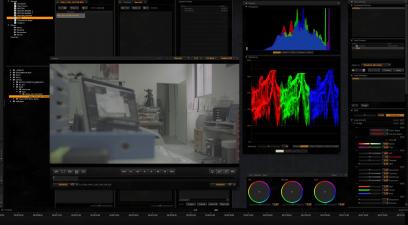A LITTLE TECHNIQUE
It’s obvious: more and more films are shot on digital dematerialized media. This evolution is accompanied by a search for the best possible quality/file weight ratio. To solve this equation, the main equipment manufacturers (Arri, RED) propose recording in RAW mode, i.e. direct recording of data from the camera sensor. We skip the complex technical details (Paul EnglebertThe image wizard at DBG will be happy to explain all this to you if you contact him – 02/653.73.23), but you should know that in the case of RAW recording, this calculation is not done by the camera, but by a downstream workstation. Over the years, the raw definition (number of captured pixels) has increased on all cameras. And so much the better! This allows video to position itself today in terms of image quality captured at the level of good old film.
Nowadays, each image weighs a lot and the sequence of images can no longer be manipulated by standard editing systems such as Avid or Final Cut Pro. It is important to know that one hour of RAW dailies represents approximately 600GB with both the Alexa and the RED Epic.
In addition, in order not to lose any information either in the high or low lights, the recorded images are “de-emphasized”. Contrast and saturation are intentionally limited. Thus, no data is likely to be clipped. But if not processed downstream, the image looks totally washed out.
In short, the digital images captured by the camera (the rushes) cannot be used as they are for editing and post-production. It is necessary to go through a stage of “Digital Development”. This is what the DNA set up by Dame Blanche Genval allows.
THE CONTRIBUTION OF THE DNA
The DNA is a mobile lab that can be rented for a day or for a longer period. The station is implemented by an operator/calibrator who provides real consultancy for the entire digital chain. It allows for fast and reliable viewing, control and processing of dailies on set. Ultimately, this approach leads to savings in the post-production phase while optimizing the initial quality of the shot.
This service brings other important advantages: the dailies are not in danger of being lost or damaged, because the memory cards are unloaded onto secure disks with transfer control and copy report. For insurance companies, this option represents much less stress. And therefore the prospect of cheaper contracts for production.
From the dailies on the camera’s acquisition cards, the DNA mobile lab makes two copies on transportable hard disks each day of shooting. The hard disks of the daily dailies are named LabRoll. One is provided to the production. It is a mirror copy of the dailies that serve as an archive. The production also receives pre-calibrated QuickTime files for inspection. During the shooting, a reference monitor and measuring instruments allow the director of photography to view the rushes in the best conditions. The calibration settings of the dailies will be found during the final calibration after editing.
The editor has access to pre-calibrated Apple ProRes or DNXhd files.
Once a week, for example, the other copy of the LabRolls containing the DPX dailies are sent to the post production lab. The grading will therefore start either from the raw rushes (RAW) or from the already pre-calibrated images as seen during the editing process.
Evolution? Revolution? A little of both. For the production companies, the use of this service far from being a … DNA (ineligible expense, therefore) would be rather a DBI (soon indispensable expense).
